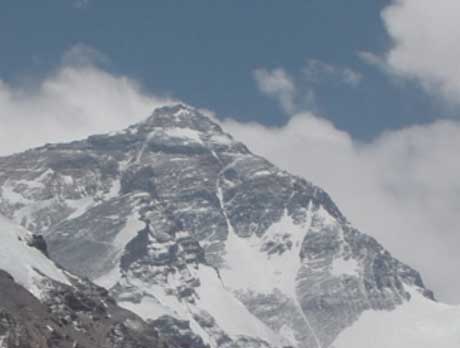
 |
|
File Photo
Copyright©Everestnews.com |
.gif)
Update June 5, 2005: Rob's
expedition leader Henry Todd has sent EverestNews.com the following
message: "Just below the Balcony he suddenly collapsed, and was
found to have died instantly of a sudden heart attack. This was
confirmed by the 3 doctors we have on the team who were climbing
with him. He had had no problems prior to this and it was completely
unexpected. All his team are shocked and saddened by this turn of
events and they are now descending the mountain to Base
Camp".
Update June 5, 2005: First the official press
release that will be published everywhere.
As per the report of
Liaison Officer and the concerned trekking agency, the following one
member of "Jagged Globe Everest Expedition 2005" team died at the
altitude of 8450 m. on the way to the summit of Mt. Everest on 5th
June 2005.
1. Mr. Robert
William Milne (49 yrs.), Software Engineer, Livingston,
Edinburgh, Scotland, UK.
The 7
members above mentioned expedition team was permitted to climb 8848
meter high Mt. Everest from normal route for the period of 75 days
from 29th March, 2005 under the leadership of Mr. Kenton Edward Cool
from UK.
The
handling agency of the expedition team is Summit Nepal Trekking,
Kathmandu, Nepal
The Ministry of Culture,
Tourism and Civil Aviation expresses its deep sorrow on his sad
demise. (Umesh Kumar Singh) Under Secretary
EverestNews.com Notes: Rob Milne was climbing with
Henry Todd's group, not the British commercial company Jagged
Globe, but apparently as you can see above he was on the Jagged
Globe permit. Commercial companies do this all the time to save
money.
EverestNews.com spoke with Rob several
time before he left for Everest. Rob "born in Montana, grew up in Colorado,
University in Boston, then PhD in Edinburgh. after that I worked 3
years in Dayton and 1 year in DC before moving back to Scotland 18
years ago. I'm a dual national, UK and USA. But Scotland is really
my home now."
Rob was very interested in new
technology that might save climbers lives. See below for more.
Henry Todd is returning to Mt Everest again in
Spring 2005 to lead the Himalayan Guides 2005
Everest Expedition. Sue (Harper)
Todd, who summited last year, will assist but not stay and attempt
the summit this year...
Rob
Milne is one of his climbers, more to follow..
Hi-tech
support helps Everest climber's bid to join elite
Pioneering technology that enables climbers and explorers
to plan expeditions more effectively – and could even help to save
lives – will be ‘road tested’ by a Scottish-based mountaineer on
Everest this spring. Computer technology being developed at the
University of Edinburgh will allow climber Rob Milne to respond
rapidly to changing conditions and inform family and friends back
home of his progress and any alterations to his plans. Dr Milne, a
leading software engineer and entrepreneur, hopes to climb Everest
in May and so join the elite group of mountaineers to have climbed
the highest peak on each of the seven continents.
Dr
Milne, who has already climbed Carstensz Pyramid (Oceania) Vinson
Massif (Antarctica), Elbrus (Europe), Kilimanjaro (Africa), Denali
(North America) and Aconcagua (South America), will be the first
mountaineer to use the IM-PACs (intelligent messaging, planning and
collaboration) system. The technology, developed at the Artificial
Intelligence Applications Institute in the University of Edinburgh’s
School of Informatics, has been designed to provide computer support
to people and teams performing a range of tasks – not just
expedition teams operating in extreme conditions, but also key
personnel involved in planning and rescue services responding
rapidly to emergencies. IM-PACs’ foundations in artificial
intelligence planning technologies supply a framework that
encourages a methodological approach to any task and allows users to
transmit and respond to information in ways that can adapt to the
circumstances the expedition team finds itself in.
During
his ascent, Dr. Milne will be in regular contact with colleagues in
base camp who will monitor his progress against his ascent plan. A
laptop computer and satellite phone will allow details of his
current status and progress to be sent over the internet to a
support team in Edinburgh. Were conditions to deteriorate
significantly at any time, the IM-PACs technology could be invoked
to suggest alternative courses of action. Should conditions
deteriorate still further, IM-PACs could be used to widen the scope
to review the expedition’s objectives and consider other
capabilities and options, such as the availability of rescue
services, and set about marshalling these to achieve the revised
objectives.
Said Dr
Milne: “On an expedition like this, it is vital to keep track of
where you are, what you are trying to do and the contingency options
when your brain is barely able to function because of the lack of
oxygen. Giving the IM-PACs software an ultimate field test will not
only help pioneer the way for remote support, but also provide
feedback to my friends and family as to how I am progressing. That
lets me relax and concentrate on a safe ascent. This is an ideal
combination of leading edge technology to assist with one of the
greatest physical challenges on the planet.”
Professor Austin Tate, Technical Director of AIAI, said:
“Any attempt on Everest requires a lot of coordination and planning
before, during and after the expedition. This makes such ‘extreme’
expeditions good examples of the kind of thing we wish to support
with IM-PACs and AI planning technology. Supporting Rob Milne in his
final milestone for his personal ‘continent tops’ challenge is a
great opportunity to showcase what could be achieved in such
missions. Our aim is to provide technology for more effective
collaboration in extreme and emergency
situations.”
IM-PACs
is funded by Scottish Enterprise, the European Research Development
Fund (ERDF) and the School of Informatics at the University of
Edinburgh.
Updates
|



![]() • Copyright© 1998-2005 EverestNews.com
• Copyright© 1998-2005 EverestNews.com







